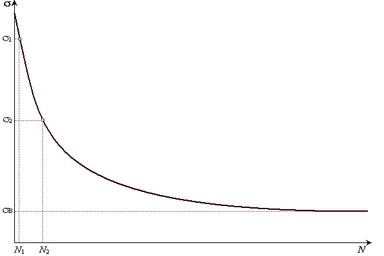 |
AutoFEM Analysis S-N Curve | ||||||
S-N curve represents the experimental curve, which is constructed according to the set of experimentally found points. The abscissa Ni of each point is equal to the number of cycles to failure of an experimental specimen, and the ordinate is the fatigue limit for a given number of loading cycles. Fatigue limit is the largest stress which does not cause the destruction of the material. Fatigue limit depends on the cycle asymmetric ratio and denoted σR. Symmetric cycle of loading gives the smallest value of the fatigue limit. Fatigue curve shows the pattern by which the increase of the number of cycles decreases the maximum stress at which the destruction of the material occurs.

After a certain number of cycles, the fatigue curve ordinates practically cease to vary. In this regard, the number of cycles (in the test material endurance) limits certain threshold, which is called the base number of cycles. If the sample can withstand a basic number of cycles, it is considered that the stress does not exceed the limit of endurance σB.
For the same material can be constructed S-N curves for various cycles of stress: symmetric (R=- 1), pulsating (R= 0), asymmetric.
There are several ways to create the S-N curve of the material in the AutoFEM Fatigue Analysis. S-N curve may be:
•selected from the list of predefined curves;
•generated being based on the material properties and a template;
•created manually using the experimental data.
See also: S-N Curve on Template, S-N Curve by Points, Assigning Material, Creating New Material, Creating New Material from Template, Anisotropic Materials, Temperature Curves, Assigning Thicknesses, Export / Import of Materials, Getting Materials from ShipConstructor, Physical Properties